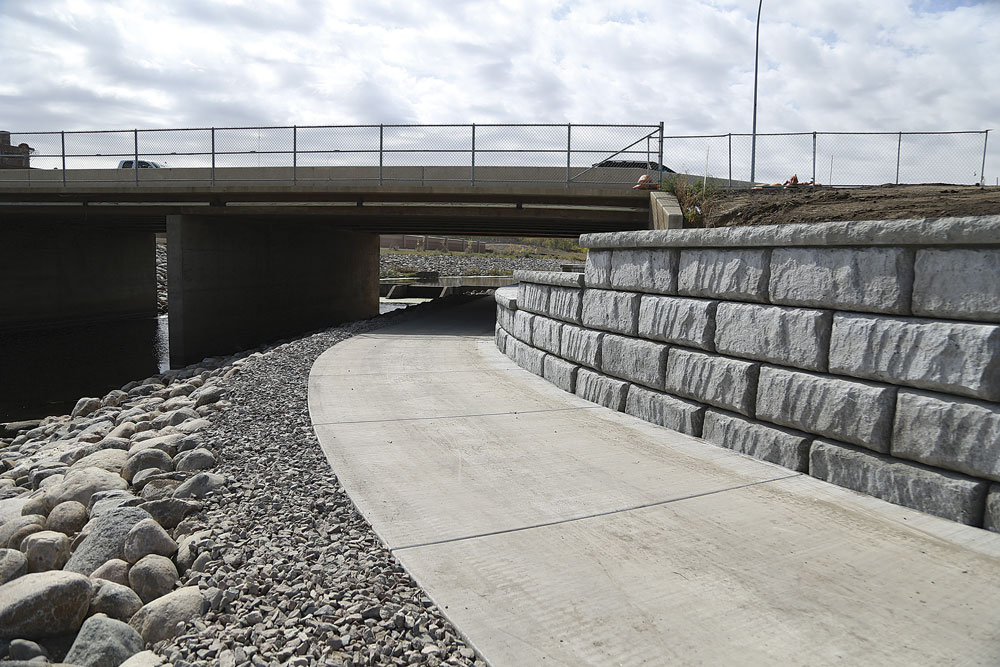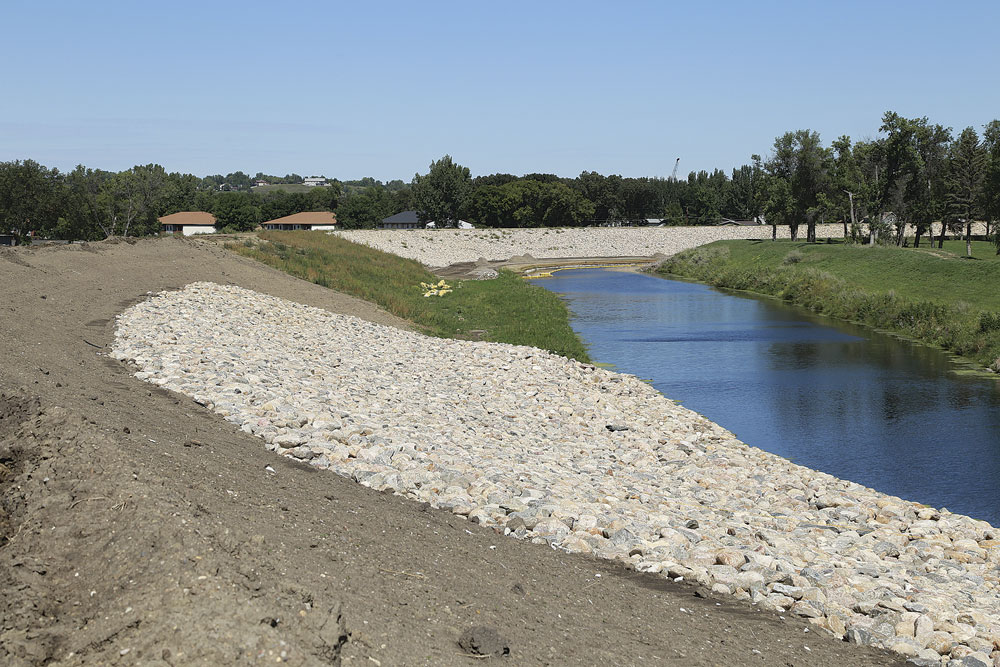Slowly building as quickly as possible
Souris River flood protection has ways to go

A walking and maintenance path runs under the 16th Street bridge through an area of completed enhanced flood protection project in Minot.
Building flood protection for the Souris River Basin as fast as possible can be a slow process.
The future of flood protection rests on the ability to get funding, said Ryan Ackerman, administrator for the Souris River Joint Board (SRJB).
“We will build as quickly as we can afford basically. That is going to be highly dictated by state funding,” he said. “We will be in a position locally to bond for our share on that, but that needs to be balanced as well with the city’s ability to make debt service on a bond through collection of sales tax.”
Ackerman said the priority for funding in approaching the 2023 Legislature will be the Maple Diversion project. The following biennium, the focus will be on the milestone to complete flood protection for Eastwood Park, Roosevelt Park and the downtown area on the south side of the river.
“That will likely take a couple of bienniums to fund,” Ackerman said. “Following that, we’d be looking at Minot milestone three, which is essentially from the Lowe’s Garden Center area through the eastern end of town.”

A levee in west Minot was among the first pieces of enhanced flood protection put in place in the city.
Within each milestone, there are major features such as levees, flood walls and pump stations. In milestone three, a diversion channel is proposed at 27th Street Southeast to bypass the Green Valley and El Rio Drive neighborhoods.
The 27th Street Diversion will be similar to the Maple Diversion in size and configuration, although costs will be less. Ackerman explained there’s no railroad affecting the work at 27th Street and there’s a fair amount of undeveloped land that makes acquisition easier and utility relocation less expensive.
“If you consider status quo appropriation levels,” he said,” it’s going to take us an additional 20 years to fully fund the construction of the project. If we can implement this as quickly as possible – if funding was no object – we could probably get it done in six to seven years.”
Bonding through the state to pay for the project would advance the work more quickly, but the reality is flood protection is likely to finish somewhere between the seven to 20 years, Ackerman said. Legislation that has been working its way through the 2021 Legislature would allow for completion in another 16 years.
The focus isn’t all on Minot, either. Work on rural aspects of flood control are and will continue to be advanced in parallel with work continuing inside Minot.
The flood protection plan includes bridge replacements in Sawyer, Velva and at Mouse River Park in 2022 and 2023. Ackerman said those projects will address bottlenecks, or pinch points, for the river flowing through those communities. The bridges will reduce flood risk as a first phase of work to be done in those areas, he said.
In Burlington, replacement of the Colton Avenue bridge was completed in May 2020. Construction of levees on the south end of the community began last year and another phase getting started will add levees on the north side of Colton Avenue. A final phase remains and is in the property acquisition stage.
Design work on the levee to protect the Robinwood subdivision, west of Minot, is in the 2021-23 work plan. Initial funding for construction will be sought in the 2023-25 biennium.
“Additionally, there’s some work being considered to reduce flood risk in other rural areas that won’t have a levee. So whether that’s by improving conveyance in some areas or addressing pinch points in rural bridges, we’ll be evaluating the viability of some of those options,” Ackerman said.
Down the road, flood protection systems will be designed for Sawyer, Velva and at-risk rural subdivisions.
“Unfortunately, we have to establish a priority list to decide which projects we’re going to work on first,” Ackerman said.
Often, priority is determined by the amount of damage sustained in the 2011 flood or by identifying areas of greatest vulnerability, he said. Communities that fought the 2011 flood and won or didn’t sustain as much damage typically end up as a lower priority because of that demonstrated resilience, he said.
“Nobody likes hearing that, but that’s the reality of what we have to do, given constraints on the budget,” Ackerman said.
Individual rural properties already have been addressed through the StARR program, which provided structure acquisitions, relocations or ring dikes.
The piece that is separate from the flood protection project is management of Canadian dams that have reserved space for flood protection. River management is being studied, but Ackerman said reservoir operations are unlikely to see significant changes. Enhanced instrumentation to better evaluate the hydrology of the basin should help going forward, although Ackerman noted the climate, geology and hydrology of the region create a volatility that makes managing for flood years challenging.
- A walking and maintenance path runs under the 16th Street bridge through an area of completed enhanced flood protection project in Minot.
- A levee in west Minot was among the first pieces of enhanced flood protection put in place in the city.


